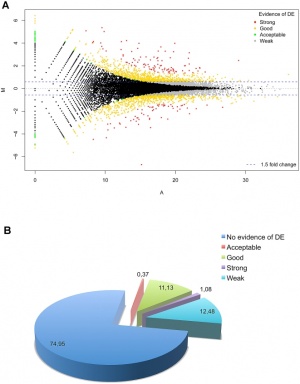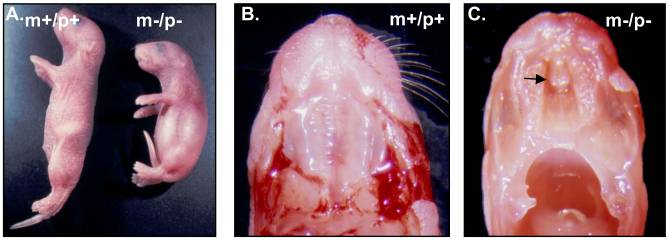User:Z3292953: Difference between revisions
No edit summary |
No edit summary |
||
| Line 33: | Line 33: | ||
- Spina bifida and atrial septal defect | - Spina bifida and atrial septal defect | ||
--[[User:Z3292953|z3292953]] 21:36, 3 August 2011 (EST) | --[[User:Z3292953|z3292953]] 21:36, 3 August 2011 (EST) | ||
| Line 38: | Line 39: | ||
====Question 1==== | ====Question 1==== | ||
Identify the ZP protein that spermatozoa binds and how is this changed (altered) after fertilisation. | Identify the ZP protein that spermatozoa binds and how is this changed (altered) after fertilisation. | ||
The protein that binds sperm is zonapellucida 3. After fertilisation, enzymes affect ZP3 modifying it, which causes it to not be able to bind. | The protein that binds sperm is zonapellucida 3. After fertilisation, enzymes affect ZP3 modifying it, which causes it to not be able to bind. | ||
====Question 2==== | ====Question 2==== | ||
Identify a review and a research article related to your group topic. | Identify a review and a research article related to your group topic. | ||
Novel concepts in evaluating antimicrobial therapy for bacterial lung infections in patients with cystic fibrosis.Rogers GB, Hoffman LR, Döring G. J Cyst Fibros.2011 Jul 18. [Epub ahead of print] | Novel concepts in evaluating antimicrobial therapy for bacterial lung infections in patients with cystic fibrosis.Rogers GB, Hoffman LR, Döring G. J Cyst Fibros.2011 Jul 18. [Epub ahead of print] | ||
| Line 48: | Line 51: | ||
--[[User:Z3292953|z3292953]] 15:43, 9 August 2011 (EST) | --[[User:Z3292953|z3292953]] 15:43, 9 August 2011 (EST) | ||
| Line 57: | Line 61: | ||
====Question 1==== | ====Question 1==== | ||
What is the maternal dietary requirement for late neural development? | What is the maternal dietary requirement for late neural development? | ||
Both maternal dietary folate and choline are important in late neural development. A deficiency in these may result in abnormalities. PMC2869500 | Both maternal dietary folate and choline are important in late neural development. A deficiency in these may result in abnormalities. PMC2869500 | ||
| Line 77: | Line 81: | ||
--[[User:Z3292953|z3292953]] 12:03, 16 August 2011 (EST) | --[[User:Z3292953|z3292953]] 12:03, 16 August 2011 (EST) | ||
| Line 104: | Line 109: | ||
--[[User:Z3292953|z3292953]] 11:19, 24 August 2011 (EST) | --[[User:Z3292953|z3292953]] 11:19, 24 August 2011 (EST) | ||
===Lab 5=== | ===Lab 5=== | ||
| Line 114: | Line 120: | ||
--[[User:Z3292953|z3292953]] 10:08, 1 September 2011 (EST) | --[[User:Z3292953|z3292953]] 10:08, 1 September 2011 (EST) | ||
===Lab 6=== | ===Lab 6=== | ||
| Line 136: | Line 143: | ||
--[[User:Z3292953|z3292953]] 16:34, 14 September 2011 (EST) | --[[User:Z3292953|z3292953]] 16:34, 14 September 2011 (EST) | ||
===Lab 7=== | |||
====Question 1==== | |||
Are satellite cells (a) necessary for muscle hypertrophy and (b) generally involved in hypertrophy? | |||
====Question 2==== | |||
Why does chronic low frequency stimulation cause a fast to slow fibre type shift? | |||
==Reference== | ==Reference== | ||
<references/> | <references/> | ||
Revision as of 11:17, 15 September 2011
Lab 4 Online Assessment
- The allantois, identified in the placental cord, is continuous with what anatomical structure?
- Identify the 3 vascular shunts, and their location, in the embryonic circulation.
- Identify the Group project sub-section that you will be researching. (Add to project page and your individual assessment page)
--[[User:Z3292953 13:17, 3 August 2011 (EST)
Lab Attendance
Lab 2- I was here for Lab 2, you saw me but I didn't do lab attendance.
Lab 3- --z3292953 11:03, 11 August 2011 (EST)
Lab 4- --z3292953 11:09, 18 August 2011 (EST)
Lab 5- --z3292953 11:26, 25 August 2011 (EST)
Lab 6- --z3292953 11:26, 1 September 2011 (EST)
Lab 7- --z3292953 11:02, 15 September 2011 (EST)
Individual Assessment
Lab 1
Question 1
-The first in vitro birth was Louise Brown in 1978 in The UK. The Nobel prize went to Robert G Edwards in 2010
Question 2
- Pregnancy after Age 50: Defining Risks for Mother and Child. Kort DH, Gosselin J, Choi JM, Thornton MH, Cleary-Goldman J, Sauer MV. Am J Perinatol. 2011 Aug 1. [Epub ahead of print] PMID: 21809262 [PubMed - as supplied by publisher]
The paper discusses the risks involved with pregancy for women over 50 years of age. It compares risks such as gestational diabetes, hypertensive disorders and abnormal placentation for women over 50 with women under 50.
Question 3
- Spina bifida and atrial septal defect --z3292953 21:36, 3 August 2011 (EST)
Lab 2
Question 1
Identify the ZP protein that spermatozoa binds and how is this changed (altered) after fertilisation. The protein that binds sperm is zonapellucida 3. After fertilisation, enzymes affect ZP3 modifying it, which causes it to not be able to bind.
Question 2
Identify a review and a research article related to your group topic. Novel concepts in evaluating antimicrobial therapy for bacterial lung infections in patients with cystic fibrosis.Rogers GB, Hoffman LR, Döring G. J Cyst Fibros.2011 Jul 18. [Epub ahead of print]
Vitamin D receptor agonists inhibit pro-inflammatory cytokine production from the respiratory epithelium in cystic fibrosis.McNally P, Coughlan C, Bergsson G, Doyle M, Taggart C, Adorini L, Uskokovic MR, El-Nazir B, Murphy P, Greally P, Greene CM, McElvaney NG.J Cyst Fibros. 2011 Jul 22. [Epub ahead of print]
--z3292953 15:43, 9 August 2011 (EST)
Lab 3
Image uploaded in Lab 2
Question 1
What is the maternal dietary requirement for late neural development?
Both maternal dietary folate and choline are important in late neural development. A deficiency in these may result in abnormalities. PMC2869500
Question 2
Upload a picture relating to you group project.
--Mark Hill 12:13, 16 August 2011 (EST) Better, but you really do not need to call the image "File".
What was wrong with "Mouse - Perinatal lethality and cleft palate deletion from Ube3a to Gabrb3" or "Lethality and cleft palate mice homozygous deleted Ube3a to Gabrb3".
--z3292953 12:03, 16 August 2011 (EST)
Lab 4
Question 1
The allantois, identified in the placental cord, is continuous with what anatomical structure?
The allantois extends into the connecting stalk and gives rise to the umbilical cord. It eventually becomes the urachus in the bladder of an adult. The urachus is also referred to as the median umbilical ligament.
Question 2
Identify the 3 vascular shunts, and their location, in the embryonic circulation.
1. Ductus Arteriosus - connects the pulmonary artery and the descending aorta
2. Ductus Venosus - connects the inferior vena cava and the umbilica
3. Foramen Ovale - connects the two atria
Question 3
Identify the Group project sub-section that you will be researching.
For the group project I will be researching Developmental Staging and Abnormality Classification.
--z3292953 11:19, 24 August 2011 (EST)
Lab 5
Question 1
Which side (L/R) is most common for diaphragmatic hernia and why?
The most common side for diaphragmatic hernia is the left side. This is due to the pleuroperitinal canal being larger on the left side than on the right. It may also be due the fact that the left side closes slightly later than the right.
--z3292953 10:08, 1 September 2011 (EST)
Lab 6
Question 1
What week of development do the palatal shelves fuse?
The palatal shelves fuse in week 9 of development.
Question 2
What early animal model helped elucidate the neural crest origin and migration of neural crest cells?
The chicken model.
Question 3
What abnormality results from neural crest not migrating into the cardiac outflow tract?
Tetralogy of Fallot
--z3292953 16:34, 14 September 2011 (EST)
Lab 7
Question 1
Are satellite cells (a) necessary for muscle hypertrophy and (b) generally involved in hypertrophy?
Question 2
Why does chronic low frequency stimulation cause a fast to slow fibre type shift?
Reference
- ↑ <pubmed>2924885</pubmed>

